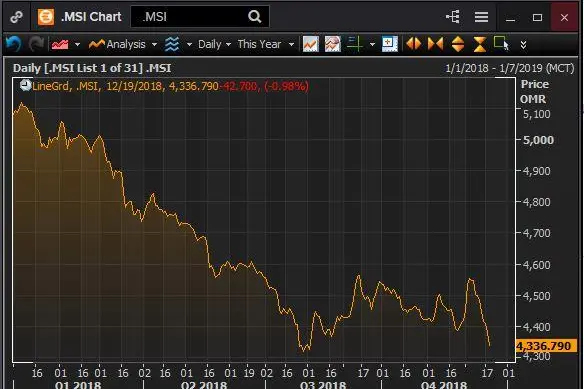PHOTO
Credit ratings agency Fitch Ratings on Tuesday downgraded Oman's long term foreign currency issuer default rating (IDR) to 'BB+' from 'BBB-'with a stable outlook, as the sultanate's total foreign assets fell to the lowest level since 2011 and the impact of lower oil prices begins to take hold, analysts said.
“Fitch’s downgrade of Oman’s ratings was inevitable given the recent fall in oil prices. Oman is particularly vulnerable to oil price changes due to its heavily oil-reliant economy. Also, prospects of support from wealthier neighbouring GCC states are weak, if not entirely non-existent,” Ayisha Zia Hassan Naseer, research analyst at Ubhar capital, told Zawya by email.
Oil prices have dropped 15.41 percent so far since the start of the year, and have averaged at $72.21 per barrel in 2018, data from Eikon showed on Wednesday.
In its May regional outlook for the region, the International Monetary Fund (IMF) calculated the breakeven point for Oman at $77.1 per barrel.
“The country’s Central Bank’s foreign assets reached OMR 5.38bn [$13.99 billion] at the end of Sept'18, down by 18%YoY (year on year) and 4% MoM (month on month), falling below the TTM (trailing twelve months) simple average of OMR 6.31bn and to the lowest level since 2011,” Naseer added, noting that this data points to a deterioration in the country’s ability to defend its currency peg to the USD.
“However, State General Reserve Fund and Oman Investment Fund collectively have a further (rough estimate) USD 32bn (according to various news sources) which should be sufficient for the time being to defend the USD-OMR peg,” Naseer added.
Oman’s stock market has dropped 14.95 percent during the year 2018 and was last down 0.98 percent on Wednesday.
In October, another rating agencies, Moody’s, maintained a negative outlook for the Omani banking sector. Moody’s said that the negative outlook reflects “the diminishing capacity of Oman's government to support the country's banks in case need”.
Fitch said in the press release on Tuesday that it views the “the banking system as relatively strong, with regulatory capital at around 16 percent of risk-weighted assets and non-performing loan ratios in the low single digits (despite a recent up-tick).
The Omani banking sector as a whole has seen shares drop by 3.97 percent since the start of the year, with two of the biggest banks on the index - in terms of market capitalization - Bank Dhofar and National Bank of Oman dropping by 22.88 percent and 6.02 percent, respectively, this year, according to data from Eikon.
“On the positive side, however, Oman's deficits could possibly shrink in the coming years as it has been spending on projects such as airports, highways and industrial zones,” Ubhar Capital’s Naseer said.
“However, the timeline on these developments to bear fruition is still some time away into the future, such as Duqm Refinery which is expected to be operational by 2022 and Liwa Plastics which is expected to be operational by 2020.”
Duqm Refinery, a joint venture between Oman Oil Company and Kuwait Petroleum International, signed seven loan agreements amounting to $4.6 billion earlier this month. (Read more).
Liwa Plastics is a project for Oman Refineries and Petroleum Industries’ (Orpic), which is expected to be completed in 2020. The project is a $3.6 billion new steam cracker that is being developed in the Sohar Industrial Port Area by Orpic.
Elsewhere in the region, Dubai’s index added 1.32 percent on Wednesday, Abu Dhabi’s index gained 0.64 percent, Qatar’s index was mainly flat, while Kuwait’s premier market index edged 0.2 percent higher and Bahrain’s index was mainly flat.
By 15:00 GST, Saudi Arabia’s index was trading 0.86 percent lower and Egypt’s blue-chip index EGX30 was 0.11 percent lower.
(Reporting by Gerard Aoun; Editing by Shane McGinley)
(gerard.aoun@refinitiv.com)
Our Standards: The Thomson Reuters Trust Principles
Disclaimer: This article is provided for informational purposes only. The content does not provide tax, legal or investment advice or opinion regarding the suitability, value or profitability of any particular security, portfolio or investment strategy. Read our full disclaimer policy here.
© ZAWYA 2018












